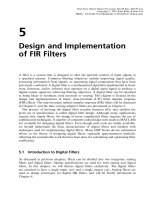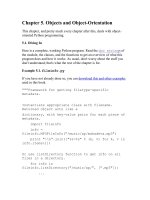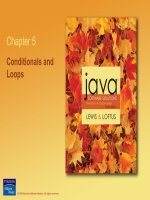Chapter 5: Conflict and cohesion in teams
Bạn đang xem bản rút gọn của tài liệu. Xem và tải ngay bản đầy đủ của tài liệu tại đây (1.45 MB, 25 trang )
1
2
3
Conflict is the disagreement and
disharmony that occur in teams
when differences regarding ideas,
members,
and
methods
are
expressed.
4
Substantive conflict occurs when members disagree about ideas,
issue analysis and potential solutions or actions
5
Affective conflict occurs when members meet differences in
personalities, communication styles, member’s beliefs, and
feelings.
6
Procedural conflict is disagreement among team members about
the method or process that the team should follow in its attempt
to accomplish a goal
7
Constructive Conflict
Destructive Conflict
Focus on Issues
• Personal Attack
Respect for Others
• Insult
Supportiveness
• Defensiveness
Flexibility
• Inflexibility
Cooperation
• Competition
Commitment to Conflict
• Avoidance of Conflict
Management
8
Competition
Concern
for OWN
GOALs
Collaboration
Compromise
Avoidance
Accommodation
Concern for TEAM GOALs
9
Be appropriated when:
• The Issue is not that important to
you
• You need time think and control
Concern
for OWN
GOALs
your emotions
• The others members are doing well
Avoidance
“Live me alone”
Concern for TEAM GOALs
10
Be appropriated when:
• You believe that the issue is not
important to achieve
goal
“Live team’s
me alone”
Concern
for OWN
GOALs
• You realize that you are wrong
Accommodation
“I give in”
Concern for TEAM GOALs
11
Competition
Be appropriated when:
“I win you lose”
• You have strong beliefs that you are
right
Concern
for OWN
GOALs
• The group must act immediately
Concern for TEAM GOALs
12
Be appropriated when:
• Need to find a solution that
Collaboration
“We win”
satisfies all team members
Concern
for OWN
GOALs
• Group have enough time
Concern for TEAM GOALs
13
Analyze
Negotiate
Mediate
Arbitrate
4 Rs Method:
- Reasons
- Reactions
- Results
- Resolution
14
Analyze
Negotiate
Mediate
Arbitrate
• Summarize areas of agreement to promote
further cooperation
• Take a break to relieve team tension
15
Analyze
Negotiate
Mediate
Arbitrate
• Is appropriated when members are unable to
resolve the conflict by themselves.
• need to choose an impartial mediator.
16
Analyze
Negotiate
Mediate
Arbitrate
• The arbitrator decides how to resolve the
conflict
• Members are obligated to accept and
implement the solution
17
Cohesive Groups feel
committed and unified;
they develop a sense of
teamwork and pride in
the group
18
Characteristics of cohesive groups:
• High levels of interaction
• Friendly and supportive climate
• A desire to conform to group
expectation
• Satisfied members
19
• Establish a team identity and tradition
Name, Logo, Motto
Uniform
Cheers, Songs
Rituals, ceremonies
…….
20
21
• Recognize and Reward Contribution
Cohesive teams establish
a climate in which praise is
encouraged
22
What is Groupthink?
Groups think is the deterioration
of group effectiveness resulted
from in-group pressure
23
Symptoms of Groupthink
• Over confident
• Considers opposition too weak
• Doubts our own reservations
• Pressure from others
• Believes everyone agree
24
Dealing with Groupthink
• As each member to become critical evaluator
• Discuss group issues with outsider
• Give members a second chance to express doubts
25









